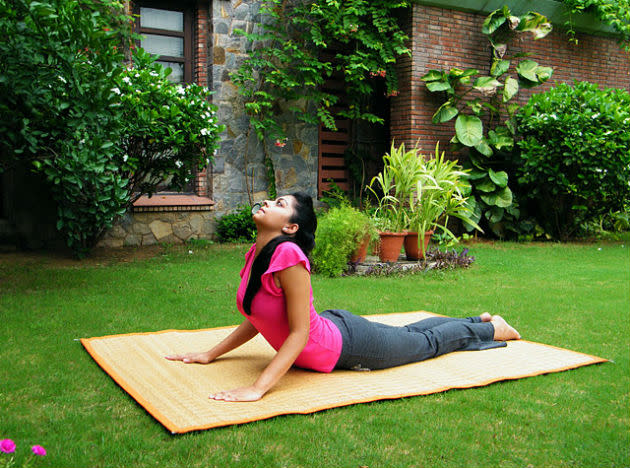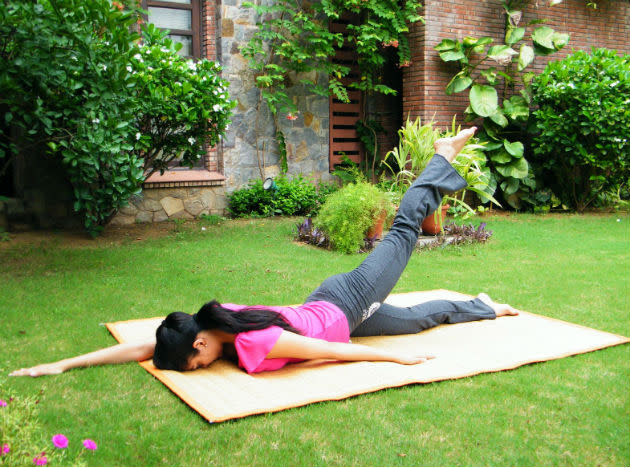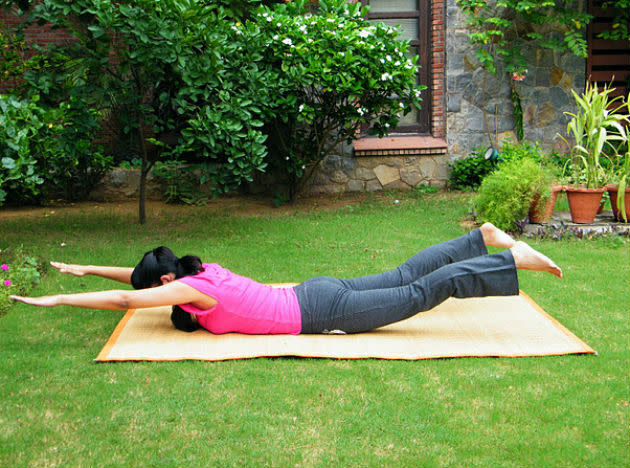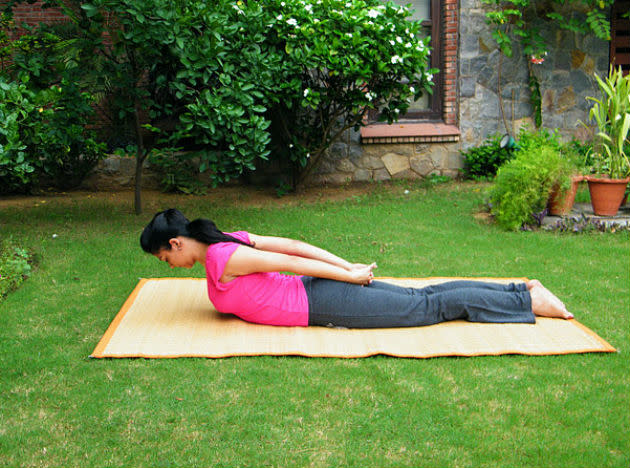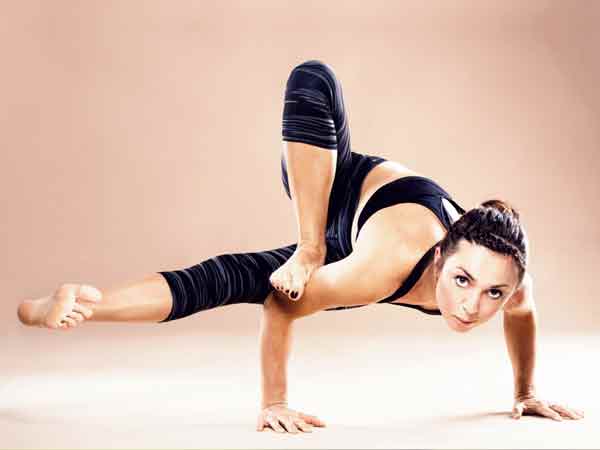Showing posts with label Procedure. Show all posts
Showing posts with label Procedure. Show all posts
Saturday, January 23, 2016
Saturday, November 14, 2015
Monday, July 6, 2015
Bhujangasana
Lie on your stomach and place your palms on either side of your chest. Raise your upper body till the navel. Look up. Hold for seven counts and gently come down. (Repeat this entire set seven times.) Caution: People with heart conditions and high blood pressure must not strain while performing these asans. It is recommended that all asans be learnt and practised under the strict supervision of an expert. For more information, you can visit the Dhyan foundation website (www.dhyanfoundation.com)
Ardh Shalabhasana (left leg & right leg)
Lie on your stomach. Extend the right arm forward and the left one backwards. Lift the left leg (as much as you comfortably can), hold for seven counts and bring it down.
Now, extend your left arm forward and the right one backwards. Lift the right leg and hold for seven counts before bringing it back down.
Now, extend your left arm forward and the right one backwards. Lift the right leg and hold for seven counts before bringing it back down.
Yaan Asana
Lie on your stomach and extend your arms forward. Now keeping your head parallel to the ground raise your upper body and your legs from the thigh. Hold for seven counts and lower down.
Sunday, June 28, 2015
Sarvangasana
This asana helps nourish the thyroid gland, which means healthy function of respiratory, alimentary, genital and nervous system.
Sarp asan
Lie on your stomach, with heels joined. Interlock your fingers behind your back. With your head parallel to the ground, raise your upper body. Pull your shoulders inwards. Hold for seven counts and lie back down.
Utthanasana
The standing forward pose or utthanasana, helps reduce fatigue and stress levels. It is also a great pose to help relieve the symptoms of menopause and improves digestion.
Vajrasana
Also known as the diamond pose, this asana can be done immediately after eating your food, unlike other yoga poses. Vajrasana is known to not only help with digestion but also help relieve urinary disorders and aids in weight loss and reduces gas in the stomach.
Apanasana
Apana refers to the prana or energy of you digestive tract that aids in purifying and eliminating toxins. This pose also gives clarity to the mind and relieves constipation.
Thursday, June 25, 2015
Adho-Mukha Savasana
- Also known as the downward dog pose, this asana provides good circulation to the head and is known to help relieve problems with the sinuses and the symptoms of the common cold as well. The downward facing dog is a great way to relieve mental fatigue, depression and insomnia.
Tuesday, June 23, 2015
Marjaryasana - A yoga asana for instant relief from backache
Marjaryasana also known as the cat pose or cat stretch is a relaxing pose that helps relieve stress and pent up tension in your back, spine and neck. This asana helps to stretch the spine, beat lower back pain, strengthens the torso and provides a gentle massage to the nerves leaving the spinal column. It also helps open up your chest — helping you breathe better and helps to maintain the proper functioning of the abdominal organs. If you need that little bit of pampering after a tiring day at work, this asana is for you.
Position yourself on your hands and your knees. Make sure your legs are directly below your pelvis and your hands are directly below your shoulders. Keep your head in a neutral position with your eyes looking at the floor. Now exhale and round your spine towards the ceiling. Make sure you do not change the position of your hands or raise your hips. Lower your head at the neck gently (leave it loose). You should feel a stretch in your back. If you feel pain, stop. Hold this position for about five counts.
Now, inhale and come back to the starting position. Next, bend your back in the opposite direction, driving your navel to the floor. Point your head gently upwards. You will feel a stretch in your spine. Hold this position for a few counts, and come back to the starting position. You can do this as many times as you feel comfortable. About five times should help you feel better.
Tip: Do not do this pose if you have a spine or knee injury.
5 yoga poses that will re-energize you, calm you, and give you a mini dose of that yoga-glow before you head out.
Standing Forward Bend
Ever flip your head over to blow dry the underside of your hair and when you flip back over your face looks kind of rejuvenated and amazing? Yup, that's exactly what we're talking about here. Standing Forward Bend will help you look and feel refreshed. Folding forward over your legs sends fresh blood and oxygen to your head and face, giving your cheeks a nice flush. It also calms the brain, reduces fatigue, and reverses the weight of gravity on the spine, bringing relief to tense back muscles -- all of which you'll likely need at the end of a crazy week.
Downward Facing Dog
Downward Facing Dog is an all-around energizing pose. In fact, B.K.S Iyengar, the founder of Iyengar Yoga, says that this is THE pose to do when you're exhausted, as it relieves fatigue and brings back lost energy. It's also a great pose to prepare for a night spent in heels as it specifically stretches areas like the hamstrings, calves, and Achilles tendons that can become tight from wearing high heels or standing for extended periods of time. Not wearing heels? It also strengthens and tones the arms, relieves tension in the shoulders, and lengthens the spine all of which will help you feel good before you head out.
Bridge pose
Bridge Pose Sitting at a computer all day can contribute to rounded shoulders and back pain. Bridge Pose is a backbend that stretches the spine and opens the chest, neck, and shoulders to counteract this daytime slumping. Going to dinner? It also stimulates the abdomen and improves digestion. Looking for love? Backbends are heart openers -- a great way send out just the right vibes.
Seated Spinal Twist
Wake yourself up and pre-detox with Seated Spinal Twist. This simple twist energizes the spine and stimulates the internal organs, encouraging detoxification. If you're planning on having a few drinks, why not flush out toxins with this easy twist? Seated Spinal Twist also stretches the back and neck muscles which feels great after a long, stressful week that's likely led to some serious muscle tension.
Sit & Breathe
Relax and feel confident by -- yes it's this simple -- breathing! Sit in a comfortable cross-legged position (try sitting on a pillow to elevate the hips). With your spine tall and eyes closed, breathe through your nose, inhaling to a count of five and exhaling to a count of five. While not exactly a "pose" controlled breathing (called pranayama) is extremely balancing and helps to calm your thoughts. It also allows you to take a minute to check in with yourself, something we don't often make time to do during the week.
TIP: Try taking 10 deep breaths in each pose as a way to re-energize and feel your best before you head out for the night. You won't regret it!
TIP: Try taking 10 deep breaths in each pose as a way to re-energize and feel your best before you head out for the night. You won't regret it!
Monday, June 22, 2015
Progressive Yoga
What It MeansProgressive yoga is a combination of Raja yoga, Ashtanga Vinyasa Yoga, and individual creativity. It is usually attributed to US-based yoga guru David Kyle. He was inspired by the yoga workouts of Sri K Pattabhi Jois and Larry Schultz. “Combining the knowledge of strength and conditioning science with yoga principles and practice, progressive yoga is tailored differently to suit your personal fitness needs, without involving competitive elements that contradict yoga’s most basic principles,” says progressive yoga instructor Praveen Tokas.
What You LearnYou are taken through correct limb positioning and associated yogic breathing. These two techniques help you to stretch the right muscles and eliminate the chance of injury.
How It WorksPostures are placed in sequential order to provide a flow practice based on specific transitions that are to be complemented in a specific number of poses. It is usually a six-week programme that teaches the foundations of a safe and effective yoga practice. Each week will build upon concepts and postures learned the previous week. The instructor uses pranayama, asanas and meditation in combination. “Asanas that stretch, strengthen and stabilise the physical body are the focus,” says Tokas.
BenefitsThe benefits of this practice are many. Injury prevention for better mobility; increased strength, power, endurance, and balance and co-ordination for optimum functional health; improved body composition; increased focus and concentration.
DangersThere are no such dangers or contra-indications of progressive yoga as long as you respect your physical capabilities and inform your teacher about any previous or current injury.
Suitable ForCouch potatoes to athletes and everyone in between. The important thing is to practise progressive yoga with a certified teacher and to respect your physiological capabilities.
Saturday, June 20, 2015
Balasana
Also known as the child’s pose, this aasana is a calming and restorative in nature. It allows you to relax and stretches out your arms, lower back and spine. Since this pose relaxes you it is best to beat stress and relieve gastrointestinal symptoms related to the condition. So, after that tiring day at work, this is the best aasana for you. (Read: Feeling stressed? Try these natural remedies)
Steps to do this pose: Start with your knees on the floor, now rest your buttocks on your feet. Make sure your back is straight and your hands are resting on your knees. Now exhale, and while using your hands as support, slide down and forwards into the child’s pose. Once here, breathe in and out slowly. Just relax and let your body calm down. The goal is to have your forehead touch the ground, but if you can’t do not push yourself. Hold this pose for as long as you are comfortable. Now to come out of this pose inhale and use your hands to push up your upper body. Rise slowly and try not to put too much pressure on your back.
Tips to remember: If you suffer from acidity, are pregnant or have a lower back injury do not do this pose.
Noose pose or pasasana
Highly beneficial for menstrual discomfort, sciatica, mild back, shoulder and neck pain, pasasana is also known as the noose pose for the type of twist one is in while doing this pose. The aasanastretches the muscles of the back, ankles and groin.
It stimulates the uterus and improves digestion and beats constipation. Moreover it helps relieve lower back pain that so many of us experience during our periods.
Steps to do this pose:
- Start by standing tall, with your hands in the namaste position.
- Keep your feet together with your back straight.
- Now bend your knees and squat such that your buttocks are resting on your calves.
- Exhale and stretch your right hand over your left knee such that your forearm passes over your shin.
- This will cause your back to twist. Take your free hand behind your back and clasp the other hand.
- Either you could interlock the fingers of both your hands or hold the wrist of either hand.
- Hold this position for ten to fifteen minutes while breathing gently. To get out of the pose, release one hand and slowly twist out of the position.
Tip: Do not do this pose is you suffer from a knee, back or neck injury.
Camel pose or ustrasana
Especialy good to treat respiratory ailments, mild backaches, fatigue and anxiety, the camel pose is perfect to relieve menstrual discomfort. Just like the bow pose this aasana also stretches the front of the body, ankles, thighs, groin, abdomen and chest.
It stimulates the abdominal organs, increasing the blood flow to the uterus helping it heal faster. It also relieves back ache and helps your body relax.
Steps to do this pose:
- Kneel on your yoga mat and press your shin onto the floor, such that it is flat against the mat.
- Now place your hands on either sides of your pelvis, with your fingers pointing downwards.
- Make sure your palms are resting on the top of your hip bone. This will help support your back when you bend backwards.
- Next, push your tail bone downwards and forwards while keeping your upper body upright. Inhale and tilt your head back, with your chin pointing to the sky.
- Gently lean back forming a inward arch in your back.
- Now place your palms on the soles of your feet for added support.
- You should feel a stretch right from your chin down to your belly or groin. Hold this pose for fifteen to twenty seconds, exhale and come back to your original position.
Tip: Do not do this pose if you have neck of back pain, high blood pressure or suffer from migraines.
Fish pose or matsyasana
This pose, just like the dhanurasana, is great to beat fatigue, menstrual pain, anxiety etc. But the best part about this pose is that it gives you that natural glow. It also stretches out the muscles of the back, neck, chest and legs giving you instant relief from muscle aches and pains associated with menstruation. This pose helps stimulate the organs of the stomach and abdomen, fighting indigestion, gas and that feeling of bloating.
Steps to do this aasana:
- Lie flat on the floor with your knees bent and your feet flat on the floor.
- Now straighten your legs, place your arms on either side.
- Raise your hips, one side at a time and place your hands under each hip.
- Bend your elbows and push your upper body off the floor, remember to exhale as you do this.
- Only raise your chest, and tilt your head backwards. Hold this pose for five counts and inhale as you rest your back back on the floor.
Tip: If you suffer from high blood pressure or have neck/back pain, avoid doing this pose.
Bow pose or dhanurasana
This pose is excellent to beat constipation and respiratory ailments. Moreover it helps relieve backache, fatigue, anxiety and most importantly menstrual discomfort.
The aasana, distinctly bow like in structure, stretches the entire front of the body and gives that extra stretch to your ankles, thighs, groin, abdomen, chest, throat and the muscles of your buttocks.
It also helps improve posture, thereby beating lower back pain and strengthens the back muscles. Another added advantage is that since the pose causes you to put all your weight on your navel, it stimulates the organs of the abdomen. This stimulation helps ease cramps and regulate the flow of blood to and from the uterus – relieving the pain and bloating feeling one normally feels during this time.
Steps to do this pose:
- Lie on your stomach on a yoga mat, keep your feet hip width apart and place your arms by your side.
- Now bend your knees and stretch out your hand to hold your ankles.
- Now, breathe in and raise your body from the front, such that your chest is off the ground.
- At the same time lift your thighs off the ground as well.
- Try to keep your body and breathing stable. Hold this pose for fifteen to twenty seconds before returning to your original position. Remember to exhale when you release your ankles.
- This is a relaxing pose, so just enjoy the stretch and do not over do it.
Tip: Do not perform this pose if you have a neck or back injury, are pregnant, have had recent abdominal surgery or have high blood pressure.
Subscribe to:
Posts (Atom)

